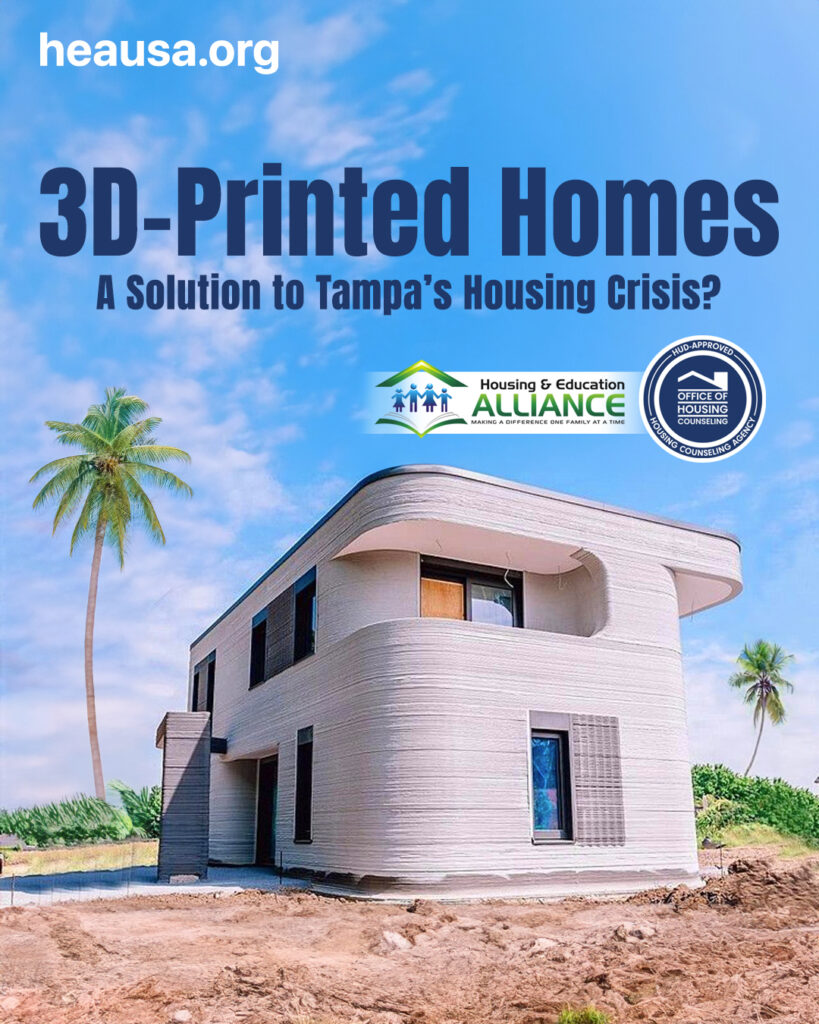
The housing crisis in Tampa, like many other cities, poses significant challenges for residents struggling to find affordable homes. Could 3D-printed homes be a viable alternative? Let’s explore the potential benefits and considerations.
The Rise of 3D-Printed Homes
- Cost-Effectiveness:
- 3D-printed homes are created using large concrete 3D printers, making them more affordable than traditionally constructed homes.
- Prices vary based on location and structure, but generally, 3D-printed homes cost less than their conventional counterparts1.
- For example, a one-bedroom 3D-printed home might cost around $15,000, with prices increasing for larger designs.
- Speed of Construction:
- 3D homes can be built rapidly, often within 24 hours, addressing the urgent demand for housing.
- Traditional construction methods take significantly longer, contributing to the housing shortage.
- Sustainability:
- With limited resources globally, 3D homes require fewer materials.
- Concrete, the primary material used in 3D printing, is durable and abundant.
Safety Considerations
- Hurricane Resilience:
- Florida faces the constant threat of hurricanes. Can 3D-printed homes withstand these natural disasters?
- Experts suggest that 3D homes, made from concrete, are sturdy enough to protect occupants during hurricanes2.
- Their durability and resistance to wind and water damage make them a viable option.
- Basic Amenities:
- While 3D homes are livable, they may lack some amenities typical in permanent residences.
- These structures prioritize affordability and functionality over luxury features.
- However, they offer insulation, airtightness, and safety comparable to traditional homes.
Success Stories
- Habitat for Humanity’s 3D-Printed Project:
- Habitat for Humanity partnered with Alquist, a 3D-printing construction company, to address affordable housing needs.
- By using concrete 3D printing, they saved up to 15% on building expenses.
- The goal: safe, affordable homes for all, fostering multigenerational wealth through homeownership3.
- Off-Grid Tiny Houses in Hurricane Zones:
- Ukrainian startup PassivDom produces 3D-printed off-grid homes.
- These self-sufficient homes can withstand hurricanes and earthquakes, powered entirely by solar energy4.
3D-printed homes hold promise as a solution to Tampa’s housing crisis. While they may not offer all the luxuries of traditional homes, their affordability, speed of construction, and resilience make them a compelling alternative. As technology advances, we may see more communities embracing this innovative approach to housing. 🏡🌟
Car Credit with The Housing and Education Alliance: Making Home Ownership More Accessible
The Housing and Education Alliance (www.heausa.org) is a recipient of the Nuevo en US grant (www.nuevoenus.org), distributed by Car Credit (www.carcredittampa.com). Using these funds, nonprofits can focus more heavily on marketing and outreach endeavors, which are so often underutilized in these organizations. However, Car Credit and Nuevo en US believe that in today’s environment, these areas are fundamental to reaching those in need. Nonprofit organizations and services must identify and be active in spaces where target populations occupy. In doing so, we build a fuller web of assistance, collaboration, and community with fewer holes to act as a springboard for anyone finding themself in an unfavorable situation in their life.
The Housing and Education Alliance encourages anyone looking for assistance in buying a new home to utilize their HomeTRACK course for a certificate to qualify for down payment assistance or special mortgage programs! The certificate from completing this course is necessary to qualify you for up to $90,000 in down payment or closing cost assistance, depending on your area and specific situation.
Steve Cuculich, owner of Car Credit, lives and operates with the belief that community understanding and support are cruxes to attaining success. Steve truly believes in building and supporting connections among people and bringing communities closer together. He accomplishes this in his endeavors bolstering nonprofits and community-building in Tampa Bay, as he states: “I am involved in a variety of businesses and investments, and take an entrepreneurial, customer-focused approach to each. However, all along the way I look for ways that my investments can give back to the community and serve a bigger picture.”








